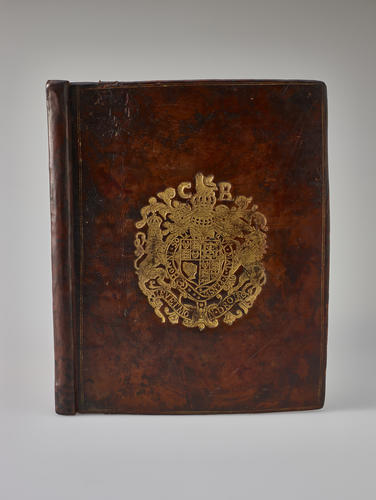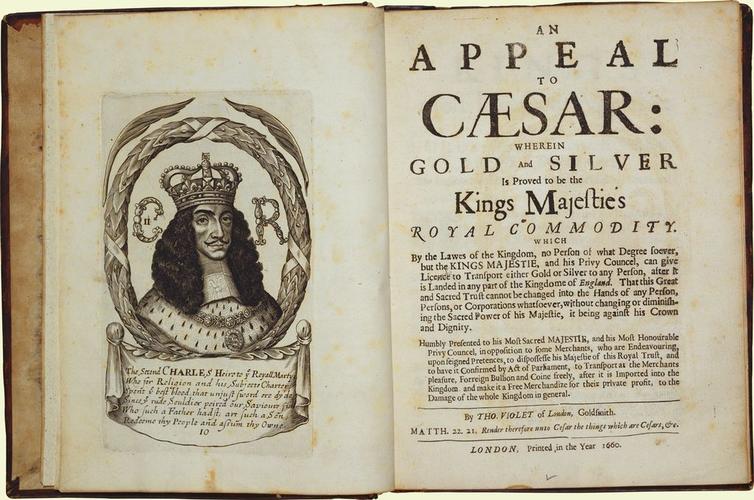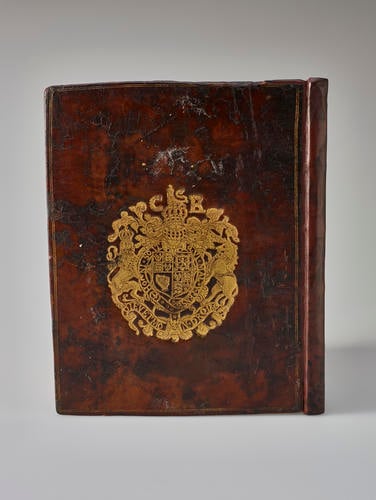-
1 of 253523 objects
An appeal to Caesar: wherein gold and silver is proved to be the King's Majestie's Royal Commodity / by Thomas Violet 1660
p. 1-46, 8 p., p. 47-58, 1 leaf of plates : port. | 22.5 cm (Height) x 1.5 cm (Depth) (book measurement (conservation)) | RCIN 1081214

Thomas Violet (d. c. 1663)
An appeal to Caesar: wherein gold and silver is proved to be the King's Majestie's Royal Commodity / by Thomas Violet 1660

Thomas Violet (d. c. 1663)
An appeal to Caesar: wherein gold and silver is proved to be the King's Majestie's Royal Commodity / by Thomas Violet 1660



-
Thomas Violet was a goldsmith and trader who was active during the turbulent reign of Charles I and subsequent Interregnum. In 1627 he was discovered to have been playing the money market by trading English silver for French gold but, as his actions were profitable to the king, he was released from prison on the condition of paying £2000 to the Crown as its share of the profit.
Following his release, Violet found a new role inspecting the trade in coins and wire. He was responsible for marking wire as authentic but discovered that like coins (the best supplies being bought up by unscrupulous traders) a lot of inferior or counterfeit metal was being traded. He prosecuted several traders, which made him very unpopular among fellow merchants.
Violet was a royalist and, due to his unpopular activities in the 1630s, spent much of the Civil War imprisoned in the Tower, having his estates and wealth confiscated by the authorities of the City of London. During this time, Violet began to write down his ideas on trade, arguing for equal treatment of merchants and traders from all nations, the reduction of customs duties and the establishment of free ports across England. This, he hoped, would bring in cheap raw materials and would benefit ordinary workers.
After his release from the Tower in 1652, Violet resumed his work inspecting the gold and silver trade. He published several works defending his actions and attacking goldsmiths and traders who he believed were draining England of its wealth by exporting the commodity.
This book is one of those treatises, published following the restoration of Charles II, it appeals to the king to recognise the importance of gold and silver in defining the wealth of the nation.
The book bears the arms of Charles II and may have been bound for the king. It was one of the books selected by the Royal Librarian Richard Rivington Holmes in 1893 as a fine example of bookbinding in the Royal Library at Windsor Castle.
Binding information
Full leather bound in brown calf, with the arms of Charles II on both boardsProvenance
Bound for Charles II. Acquired from Sotheby, WIlkinson & Hodge at the Bateman sale, 25 May 1893 (no.4955)
-
Creator(s)
(publisher)Acquirer(s)
-
Medium and techniques
p. 1-46, 8 p., p. 47-58, 1 leaf of plates : port.
Measurements
22.5 cm (Height) x 1.5 cm (Depth) (book measurement (conservation))
22.5 x 1.5 cm (book measurement (inventory))
25.0 x 3.0 cm (book in box)
Category